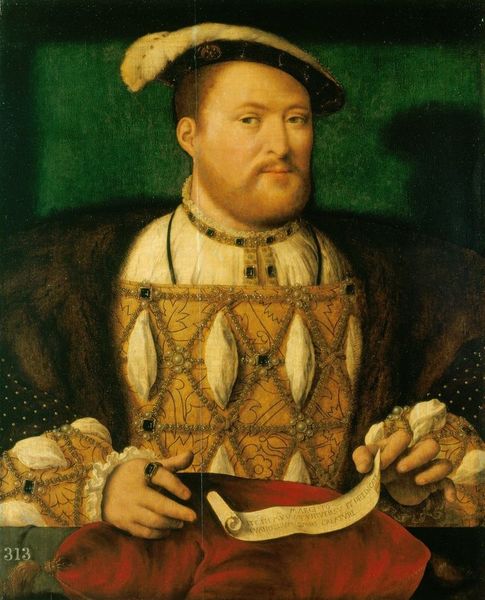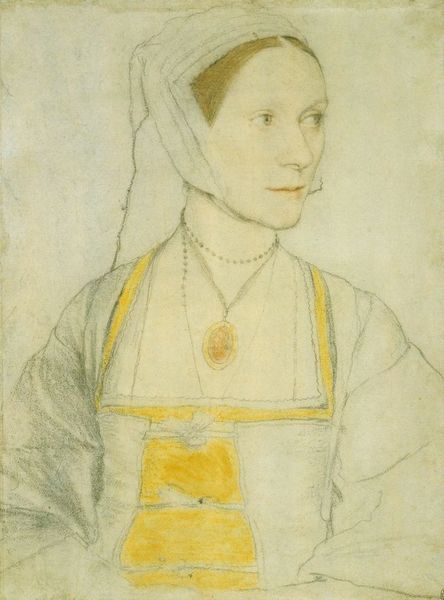The fashionable world of the Tudors and Stuarts revealed at The Queen's Gallery
Joos van Cleeve, Henry VIII, c.1530-35. Royal Collection Trust / © Her Majesty Queen Elizabeth II 2013.
LONDON.- A diamond ring given by Charles I to his 19-year-old wife, the armour of a fashion-conscious 13-year-old boy who should have been king, and the diamond-encrusted box in which a queen kept her face patches are among the highlights of a new exhibition at The Queen’s Gallery, Buckingham Palace.
In Fine Style: The Art of Tudor and Stuart Fashion provides an insight into the world of the rich and famous of the 16th and 17th centuries. The exhibition includes over 60 portraits from the Royal Collection, as well as rare surviving contemporary examples of clothing and accessories. A number of works go on display for the first time.
For the Tudors and Stuarts, jewellery was the ultimate in conspicuous consumption. Although relatively little survives from the period, two important pieces went on display for the first time in the exhibition. One of these is a gold and diamond signet ring bearing the royal coat of arms and the cypher of Henrietta Maria, given to the young Queen by her husband Charles I in around 1628, three years after their marriage. Also on display for the first time is a pendant of gold, rubies and diamond, incorporating a miniature of Elizabeth I. It was possibly presented to a courtier by the Queen as a sign of favour and worn as an earring. Earrings became an increasingly popular accessory for men towards the end of the 16th century, and it was fashionable to wear them in one ear only.
Some of the most important jewels of the period are recorded in portraits in the exhibition. Weighing 58.5 carats, ‘La Peregrina’, meaning ‘The Wanderer’, was the largest pearl in existence at the time of its discovery. This famous pear-shaped jewel is seen in portraits of both Mary I (c.1554–59), who received it as an engagement gift from Philip II of Spain, and of Margaret of Austria (c.1605), who was given the pearl when it reverted to the Spanish crown on Mary’s death. ‘La Peregrina’ was presented to Elizabeth Taylor by Richard Burton on Valentine’s Day 1969.
In the Tudor and Stuart periods, even armour followed fashion. The ornate set belonging to the 13-year-old Henry, Prince of Wales (c.1607) was designed to echo the full breeches and V-shaped doublets of the day. The armour was a gift from a French nobleman and a statement of great extravagance, particularly since the adolescent Prince would soon have outgrown it. Heir to the English and Scottish thrones, Henry died of typhoid fever at the age of 18, and his younger brother succeeded him as the ill-fated Charles I.
High-ranking sitters were painted wearing clearly impractical clothing, conveying the message that the subject enjoyed a privileged lifestyle. The fashion of extending the fingers of gloves beyond the fingertips is particularly associated with Elizabeth I. Hans Eworth’s Elizabeth I and the Three Goddesses, 1569, is the only known portrait of the Queen wearing gloves. Elizabeth was particularly proud of her elegant hands and would remove a glove for a courtier to kiss her as a mark of favour. Perhaps unsurprisingly, contemporary painters mostly chose to emphasise the Queen’s ungloved hands.
Just as today, the fashion-conscious Tudors and Stuarts copied the styles of those they admired. In 1666, Charles II announced that he was to introduce a new English fashion for men – a long vest worn under a coat instead of a short doublet and cloak. The King is seen wearing this style of coat in the painting Charles II presented with a pineapple, c.1675, which goes on display for the first time. Later to become the three-piece suit, the style spread so quickly that three weeks later the diarist Samuel Pepys was wearing his own version. Pepys records how his wife avidly followed the fashions of the court favourites, visiting the same shops at Barbara Villiers, Charles II’s mistress.
In the 17th century, black fabric patches were stuck to the face to emphasise the creamy white skin of the leisured class and to conceal blemishes. They were applied using saliva or adhesive and produced in a variety of shapes, from crescents and flowers to animals – as many as seven were worn at once. The exhibition includes a patch box of enamelled gold set with diamonds that belonged to Mary II. It dates from around the year of the Queen’s death from smallpox, which caused terrible scarring to the skin.
Portraits allowed the sitter to express different aspects of their personality through clothing. Among the 60 paintings on display are two portraits of the renowned court beauty Frances Stuart, Duchess of Richmond. Known as ‘La Belle Stuart’, she famously refused to become mistress to Charles II. In a portrait by Sir Peter Lely (c.1662) the Duchess wears a glamorous yellow silk gown. In another by Jacob Husymans (1664), she wears a masculine buff coat with her hair styled to resemble a male periwig, following the trend for women to dress in clothes inspired by male garments. This portrait went on display for the first time in the exhibition.
Exhibition curator Anna Reynolds of Royal Collection Trust said, ‘Fashion was hugely important to court life and entry to the inner circle was largely driven by personal appearance. The rich and powerful were the trend-setters of the age, and used clothing to send out messages about their taste and status’.
Hans Eworth, Elizabeth I and the Three Goddesses, 1569. Royal Collection Trust / © 2013, Her Majesty Queen Elizabeth II.
British School, 16th century, Edward IV (1442-83). Royal Collection Trust / © 2013, Her Majesty Queen Elizabeth II.
Hans Holbein the Younger (c. 1497-1543), Cicely Heron (b.1507), c.1526-7. Royal Collection Trust / © 2013, Her Majesty Queen Elizabeth II.
Hans Holbein the Younger (c. 1497-1543), Recto: Queen Anne Boleyn (c.1500-1536). Verso: A coat of arms of the Wyatt family, and other heraldic sketches, c.1533-6. Royal Collection Trust / © 2013, Her Majesty Queen Elizabeth II.
Hans Holbein the Younger (c. 1497-1543), William Parr, later Marquess of Northampton (1513-1571), c.1538-42. Royal Collection Trust / © 2013, Her Majesty Queen Elizabeth II.
Hans Eworth (1520-74?), Henry Stewart, Lord Darnley and his brother Charles Stewart, Earl of Lennox, 1563. Royal Collection Trust / © 2013, Her Majesty Queen Elizabeth II.
Attributed to William Scrots (active 1537-53), Elizabeth I when a Princess, c.1546. Royal Collection Trust / © 2013, Her Majesty Queen Elizabeth II.
Attributed to William Scrots (active 1537-53), Edward VI (1537-53), before 28 Jan 1547. Royal Collection Trust / © 2013, Her Majesty Queen Elizabeth II.
After Anthonis Mor van Dashorst (c. 1518-76), Mary I (1516-58), 1554-59?. Royal Collection Trust / © 2013, Her Majesty Queen Elizabeth II.

/https%3A%2F%2Fprofilepics.canalblog.com%2Fprofilepics%2F1%2F0%2F100183.jpg)
/https%3A%2F%2Fstorage.canalblog.com%2F03%2F02%2F119589%2F96711876_o.jpg)
/https%3A%2F%2Fstorage.canalblog.com%2F11%2F31%2F119589%2F94773502_o.jpg)
/https%3A%2F%2Fstorage.canalblog.com%2F20%2F83%2F119589%2F94772815_o.jpg)
/https%3A%2F%2Fstorage.canalblog.com%2F26%2F72%2F119589%2F75604929_o.jpg)
/https%3A%2F%2Fstorage.canalblog.com%2F59%2F60%2F119589%2F26458628_o.jpg)












/http%3A%2F%2Fstorage.canalblog.com%2F80%2F58%2F119589%2F126154676_o.jpg)
/http%3A%2F%2Fstorage.canalblog.com%2F36%2F05%2F119589%2F121372085_o.jpg)
/http%3A%2F%2Fstorage.canalblog.com%2F41%2F38%2F119589%2F94611133_o.jpg)
/http%3A%2F%2Fstorage.canalblog.com%2F82%2F45%2F119589%2F76158763_o.jpg)